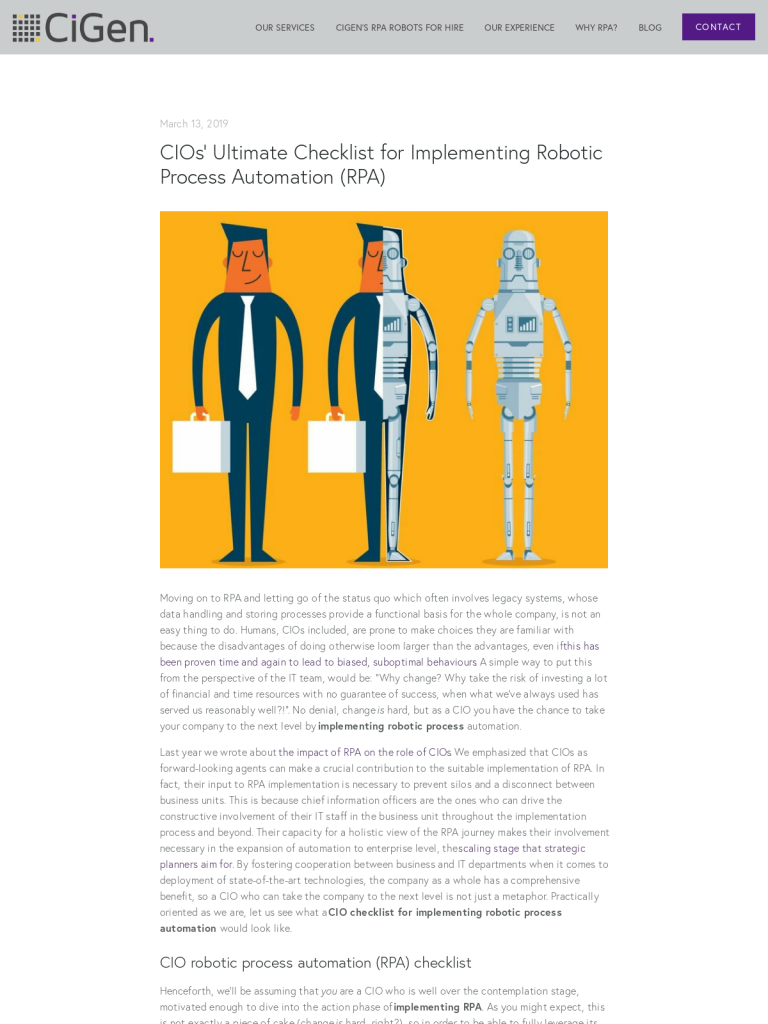CIOs’ Ultimate Checklist for Implementing Robotic Process Automation (RPA)
Original post from https://www.cigen.com.au/cigenblog/

Moving on to RPA and letting go of the status quo which often involves legacy systems, whose data handling and storing processes provide a functional basis for the whole company, is not an easy thing to do. Humans, CIOs included, are prone to make choices they are familiar with because the disadvantages of doing otherwise loom larger than the advantages, even if this has been proven time and again to lead to biased, suboptimal behaviours. A simple way to put this from the perspective of the IT team, would be: “Why change? Why take the risk of investing a lot of financial and time resources with no guarantee of success, when what we’ve always used has served us reasonably well?!”. No denial, change is hard, but as a CIO you have the chance to take your company to the next level by implementing robotic process automation.
Last year we wrote about the impact of RPA on the role of CIOs. We emphasized that CIOs as forward-looking agents can make a crucial contribution to the suitable implementation of RPA. In fact, their input to RPA implementation is necessary to prevent silos and a disconnect between business units. This is because chief information officers are the ones who can drive the constructive involvement of their IT staff in the business unit throughout the implementation process and beyond. Their capacity for a holistic view of the RPA journey makes their involvement necessary in the expansion of automation to enterprise level, the scaling stage that strategic planners aim for. By fostering cooperation between business and IT departments when it comes to deployment of state-of-the-art technologies, the company as a whole has a comprehensive benefit, so a CIO who can take the company to the next level is not just a metaphor. Practically oriented as we are, let us see what a CIO checklist for implementing robotic process automation would look like.
CIO robotic process automation (RPA) checklist
Henceforth, we’ll be assuming that you are a CIO who is well over the contemplation stage, motivated enough to dive into the action phase of implementing RPA. As you might expect, this is not exactly a piece of cake (change is hard, right?), so in order to be able to fully leverage its potential, we recommend you start by going through this CIO robotic process automation checklist.
1. The prelude to automation.
The road to success starts with a thorough examination of the company infrastructure, particularly the risk and security policies. You should consider whether these policies apply to a whole range of processes, such as system access rights or system updates, and not only to individual desktops. A holistic perspective, acknowledging the implications of RPA tools deployment for the company as a whole, across all the environments that are linked to the processes to be automated, is the way to go.
2. Finding a host for the software robots.
Allow yourself to (almost) literally think outside the box; for instance, let go of the assumption that the robots must be located within the company. Things could proceed more smoothly if you either joined forces with an infrastructure partner that can host them or if you made use of the Cloud. The Cloud works as an “all around” software system, spanning across a large plethora of business processes, so this option can also contribute to ensuring the “bird’s eye view” that we mentioned in (1) above.
3. Playing it safe.
This means that you should never lose sight of security issues that may arise in relation to automation, looking at both data and access security. Irrespective of whether you choose to rely more on your workplace devices, or whether you store confidential information (credit card numbers, financial information, passwords, etc.) about the company’s employees, customers, and vendors in the Cloud, you should remain vigilant and able to address security challenges as soon as you foresee them.
4. Keeping your feet on the ground and considering the possibility to resort to a “plan B”.
To this end, you can use to your advantage the fact that the proof of concept phase typically requires a substantial amount of time. Your plan should account for the fact that once you carry the project into full production, the bots become vital for optimal functioning rather fast. They can work full time towards the efficient accomplishment of their goals, which counts as strong positive reinforcement and thereby leads to fast habituation. When bots become an integral part of the system, it’s advisable that you have a well-thought safety net to compensate for potential failures. After all, no matter how improbable, something might go wrong at any point, so a back-up program is a wise way to go.
Thank you!
5. Fostering collaboration towards building cross-department attuned strategies.
This is the result of RPA complexity and its intricate involvement in all company sectors. Things are no longer like in the early days of RPA, when it was mostly the business units who dealt with software implementation and maintenance, with only marginal consultancy of IT practitioners. Nowadays, according to James Hall, Genfour CEO, it is concerted action that leads to the most desirable outcomes. Therefore, the best CIO when it comes to implementing robotic process automation is a “polyglot”, in the sense of someone who is able to speak the language of several departments in order to be able to fruitfully engage with IT architects, stakeholders, managers of process or business systems and applications, infrastructure providers (if you’re using them), etc.
6. Long-term planning towards enterprise-wide RPA implementation.
Extending automation at the enterprise level, after the initial smaller-scale implementation in specific departments, is the Holy Grail of digitalisation. As we mentioned previously, software robots produce the most significant gains when used at macro-scale, across multiple areas of your company. But scaling requires assistance from the IT team to ensure technical flexibility and cyber security. CIOs’ deep understanding of the technology makes them able to optimize IT performance and resource allocation. Relatedly, as a CIO, you are expected to establish an appropriate standard of scalability that the designed robots should comply with, as well as adequate infrastructure and network capabilities.
7. Helping people move beyond the myth of “robots will steal our jobs”.
This rather pervasive fear of the side effects of digitisation on the labour market is a frequent objection to implementing robotic process automation, one that can create resistance within the company and thereby slow down the progress. What can you do about it? First, acknowledge the reality of the significant change in the workforce landscape, and second (and more importantly) specify this change in terms of displacement only from the tedious, monotonous tasks that everybody actually dreads, followed by subsequent upskilling. You could also emphasize the contribution of training for higher value jobs to personal development. Reference to statistical data showing that more jobs will be created than lost thanks to technological development, such as this 2019 Gartner report, can help you make a stronger case.
Conclusion:
Your technical expertise is an undeniable asset for successful RPA deployment. Therefore, while going through this CIO robotic process automation checklist, stay up to date with related technological developments, and be prepared to include them in the flexible long-term plan that you have designed. At the same time, you should continue to grow your business knowledge. This way, you’ll be able to meet a wide category of challenges that you’re likely to encounter as the automation journey progresses. In fact, interconnectedness is the bottom-line of our suggestions for the automation-minded CIO. On the one hand, we’re talking about deepening the business – IT connection. On the other hand, we refer to consolidating the human connection by educating the employees as to what RPA can and cannot do, and by keeping the board informed regarding the achievement of the promised RPA benefits.
Leave a Comment
You must be logged in to post a comment.








